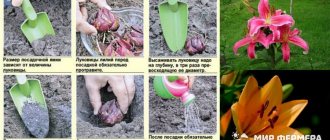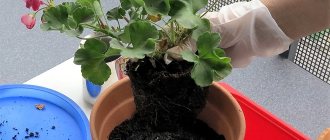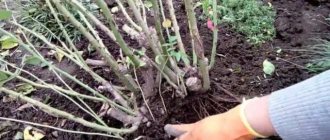To deepen or not to deepen the grafting site of roses when planting
Rose planting and grafting. Should I bury the vaccine and how deep? Is it necessary to bury the rose grafting site into the ground when planting and for how long?
This topic remains controversial among both professional rose growers and amateur gardeners. What is the correct way to bury the graft, plant it level with the ground or even above it? I invite rose lovers to share their experiences on this controversial issue, and I will share mine. See also: Planting roses in open ground
Planting a grafted rose
Before you start planting a seedling, you need to decide on the timing. Most gardeners prefer to plant grafted roses in the spring. At this time of year the weather is warm, and the bush will quickly take root in its new location.
What does a healthy rose bush look like?
But you shouldn’t be afraid of autumn plantings. If the work is carried out at the right time, then by winter the seedlings will have time to take root, and in the spring they will begin to actively grow. The optimal planting time in the fall is from the beginning of September to the first ten days of October in the middle zone. In summer, a rose is planted only in extreme cases.
Note! Another important point is that before planting in the ground, the seedling must be carefully examined. If the stems and root system have dried out, the rose should be placed in water for several hours.
Growth stimulants
How to root a rose from a bouquet? At home, many novice gardeners neglect the achievements of modern chemistry, and completely in vain. Growth stimulants activate root growth, the bush will take root faster and will not hurt for a long time.
You can prepare growth stimulants yourself - from water and honey (a teaspoon per liter of water) or aloe juice with water in a ratio of 1:10.
You can also buy them in the store. The drugs “Kornevin”, “Radifarm”, “Zircon”, “Epin extra” are very popular (use according to the instructions on the package).
How to grow a rose? We prepared cuttings from the cut flower, now comes the stage of root germination.
Basic mistakes
When is the best time to plant roses in open ground?
Mistakes when planting:
- close occurrence of groundwater at the planting site. The culture does not like wet soil. If the soil does not dry out for a long time, this leads to rotting and death of the root system. In addition, in winter, the wet substrate cools more strongly, and this leads to freezing of the roots;
- planting roses in the shade. These plants are photophilous and heat-loving, and sunlight has a decisive effect on the growth of the flower and its resistance to fungal diseases. The longer the rose is in the sun, the better;
- the grafting site is very deep. This can lead to bud rot and death of the bush;
- the soil was not treated and prepared before planting. Before you plant a rose in the ground, you need to prepare it. The soil is dug up to a depth of 15 cm, all weeds are pulled out and fertilizers are applied. You can also water the soil with a solution of potassium permanganate. These measures will help prevent the appearance of pests and destroy pathogenic microorganisms in the soil;
- high level of substrate acidity. Roses prefer neutral soil. Acidity should be between 6-7. In such soil it is easiest for flowers to absorb nutrients;
- planting a flower in a draft. As mentioned above, roses are heat-loving plants, and cold drafts can destroy them;
- It is not recommended to plant the crop under the canopy of trees. Trees will not only block the rose from sunlight, but also deprive it of water and nutrients.
Important! An important factor is the subsequent care of planted bushes. If you do not apply fertilizers, organize watering and regularly loosen the soil, it will be more difficult for the rose to take root in a new place.
In potatoes
How to grow roses? Cuttings from a bouquet need to be stuck into potatoes - this unconventional planting method is being practiced by more and more flower growers. Potato tubers are a perfectly balanced medium of liquid and starchy substances, and it is ideal for root germination.
For rooting, you need to choose good tubers - medium-sized, strong, without signs of sagging or rot. The potatoes are thoroughly washed and placed in a pink solution of potassium permanganate for disinfection. Then they dry and cut out a recess corresponding to the diameter of the stem. It doesn't have to be cross-cutting.
A cutting is placed in the hole and the tuber is buried in a pot with soil, watered and covered with a transparent plastic bottle to create a greenhouse. After the first shoots appear, the seedling needs to be ventilated at least once a day.
Some gardeners, after the roots appear, break the potatoes and replant the plant in the ground. Others prefer to leave the tuber as a natural fertilizer.
How to plant a grafted rose correctly
Lupine as green manure - when to sow and when to bury
If the bush and the place for planting it are ready, you can begin the main process. It takes place in several successive stages.
When choosing a site for a bush, you need to remember that it will have to be covered for the winter. Grafted roses have a weaker above-ground part, and even slight frosts in winter can destroy the bush.
How to plant a grafted seedling
Note! If you are planting roses in the fall, first shorten the shoots to 5-8 buds and tear off all the leaves. Pruning helps awaken the buds, which in the future produce strong skeletal shoots.
How to plant grafted roses in a garden plot:
- Before planting the bush, you need to make a clay mash. Dilute the clay in water until it becomes creamy. Then dip the root system into the mixture. After this, they immediately begin planting, not allowing the clay to dry out.
- Dig a hole 60x60 cm with a depth of 60-70 cm. Fill the bottom with shallow drainage, then a layer of fertile soil. It is not advisable to add mineral fertilizers at this time. First you need to give the flower time to take root.
- Gently straighten the root system and fill the hole with soil. Lightly compact the soil and cover with another layer of soil. Deepening of the root collar is mandatory.
- At the end, the bush should be watered generously with warm water, even if the ground was wet.
In addition, the bush needs to be covered with earth to a depth of 10-15 cm. This will prevent the trunk from drying out and will help retain moisture in the soil.
Important! If planting was carried out in the fall, then before covering the bush for the winter, it is additionally hilled up by 30 cm. In the spring, when sprouts 2-3 cm long appear on the bush, the layer of soil is removed.
Step-by-step instructions for planting cuttings in a pot
- Treat containers and tools with a pink solution of potassium permanganate. This will avoid plant death from fungal and bacterial infections.
- Place 3-5 cm of drainage on the bottom of the container - gravel, crushed stone, broken shards. Can be replaced with pieces of polystyrene foam. For disinfection, drainage is poured with boiling water or washed with a solution of potassium permanganate.
- Place suitable soil in the pot, compact it slightly, but do not compact it. A soil mixture suitable for roses can be purchased at the store. Or you can prepare it yourself from two parts of ordinary garden soil and one part of sand. Before use, the soil must be fried on a baking sheet for disinfection.
- Make a small depression (you can use your finger), plant the cutting and sprinkle it with soil. If there is more than one seedling, then they need to be evenly distributed over the entire surface of the soil, so that there is 5-6 cm between two plants.
- Water. Slightly cool, well-settled water or rainwater.
- Create a greenhouse effect. To do this, you need to cover the entire pot with film (you can use food film). Or cover each seedling with a cut plastic bottle or disposable cup.
- The seedlings are watered as needed. To avoid washing away the roots, it is better to do this with a sprayer.
- The plants are ventilated once a day. The first sessions last 3-5 minutes. Every day, as they heal, their duration needs to be increased. As soon as the first green leaves appear, the improvised greenhouse can be removed.
Is it necessary to bury a rose graft when planting?
One of the important questions that needs to be decided is whether to bury the grafting site of the rose.
Flowers are like roses, but not roses - what are they called?
The rose is grafted depending on the region:
- In the middle zone, in order to grow a healthy rose bush, you must bury the graft. If this place is above the ground, the bush may freeze in winter, even if it is covered;
- the graft must be buried at least 5 cm;
- in the southern regions, in order to grow rose bushes, it is not necessary to deepen the grafting.
If the graft was not buried during planting, you can hill up the bush before the onset of cold weather so that this place is underground.
For your information! Roses can be grafted onto other varieties and even onto rose hips.
What flowers can be used for cuttings
Experienced gardeners know well how to grow a rose from a bouquet. Skills and abilities are acquired through many years of experimentation with different varieties of flowers. But for an amateur, this process can be difficult.
The fact is that theoretically you can work with any of the purchased roses. How to grow a rose in practice is a completely different matter. Flower growers know that winter flowers take root worse than summer ones. And at home, local varieties will take root faster than imported bushes.
For 100% success, you need to choose flowers grown in your region, cut in May-June, and not treated with chemicals. It is also worth remembering that hybrid and grafted bushes often grow roses that are completely different from the parent flower. You can experiment with non-native flowers at any time of year. But in this case, the chance of failure increases significantly.
Is it necessary to bury the root collar of a rose when planting?
When planting a grafted rose for the first time, it will be difficult for novice gardeners to determine how deep to bury the root collar and graft.
To understand whether it is necessary to deepen the root collar, you should first understand where the graft is located and what the root collar of the bush is.
The root collar is a section of the stem 3-4 cm long, located above the branch of the upper root of the seedling. The grafting is located several centimeters above the root collar, so it needs to be buried.
An exception can be made for the southern regions, where it is customary not to bury the vaccine deeper. In this case, it is not recommended to bury the root collar too much. This helps slow down the growth of the flower.
Whether a rose should be grafted or not depends on the region
The planting depth of the flower should be such that the root neck of the shoot is completely covered with soil.
Planting a grafted rose is easier than it might seem at first glance. It is enough to follow all the necessary planting rules, and then the rose will delight you with its abundant flowering for a long time.
Disembarkation
Before you grow a rose from a bouquet, you need to think about where exactly it will “live” in the future. There are two options - in the house or on the street. In the second case, you need to be aware that in our country, in most regions, winters are very harsh. And sometimes even autumn is not happy with the weather, and summer is not going well. All this can lead to the bush dying without even having time to take root in a new place.
However, there is good news for enthusiasts. Roses are grown outdoors even in regions with the most unfavorable conditions. It just takes a little more effort.
Typically, bushes are planted in open ground in late spring, in a well-lit and warm place, where they delight everyone until the first frost. Then the bushes are dug up, trimmed and placed in a pot for wintering. Some varieties can be left in the ground for the winter. But they are first carefully wrapped in straw, fallen leaves or a thick layer of sawdust.
If the plant is planned as a home plant, then it also needs to be replanted in the spring. But since the indoor microclimate is more favorable, you can plant bushes in a new pot not only in May, but also in March-April. The technology is the same as when planting cuttings.
Now you know how to grow roses from cuttings of donated roses. And no matter how capricious this plant is considered, it is very unpretentious in care. It is most sensitive to light conditions and watering. Rose loves bright places, but not in direct sunlight. In shade and partial shade, the bush quickly becomes smaller and degenerates. Watering should be regular and moderate, since excess moisture in the pot can cause the roots to rot and the bush to die.
If the air in the room is excessively dry, the rose will begin to wither and drop its barely formed buds. Therefore, the bush must be sprayed regularly. And in the summer, an indoor rose will feel good on a loggia or open veranda.
Copulation
In cases where it is impossible to carry out budding or there is reason to assume that it will be ineffective, copulation is used, that is, grafting with a cutting. It is carried out mainly in the summer, using green semi-lignified cuttings 1-2 internodes long as a scion. There are several types of copulation:
- simple;
- improved;
- into a cutout or split;
- for the bark.
Simple and improved
This method of propagation is suitable for roses when the rootstock and scion are of the same thickness or the first is larger than the second. In this case, the diameter of the stem of the “donor” plant must be at least 7.5 mm. The shoots chosen are strong, dense, with mature wood and 2-3 developed buds that are at rest. Both on the rosehip and on the cuttings of a varietal rose, an oblique cut (at the same angle) is made, about 25 mm long. It must be smooth and clear so that the plant tissues are tightly connected to each other. It is necessary to ensure that the lower bud of the scion is directly opposite the central part of the cut.
The photo shows a combination of sections of rootstock and scion cuttings with direct and improved copulation using examples of fruit crops
Improved copulation differs from simple copulation by additional cuts, thanks to which unique “tongues” are created on the sections of the rootstock and scion. This requires some skill and precise calculations, but gives very good results, as it ensures a more precise and tight fit of the cambial layers when combining cuttings.
The parts of the plants are pressed tightly against each other, tied tightly, but the bandage is not applied tightly, making sure to leave gaps between the turns. The joint and the upper cut of the scion cutting are coated with heated garden varnish to prevent weathering and pathogenic microorganisms from entering the exposed wood tissue.
In the cutout, in the cleft, behind the bark
It is advisable to use these methods in cases where the rootstock is significantly thicker than the scion cuttings. The rosehip is cut at an angle of 90 degrees, then a straight cut in the middle (split) or a vertical wedge-shaped cut on the side about 25 mm long is made in the upper part of the stump. If the bark of the rootstock separates well, you can cut it or simply move it away. Leaves are removed completely from cuttings of a cultivated variety or cut in half. A longitudinal oblique cut is made in the lower part or it is given a wedge shape. It is important to ensure that when combining parts of plants, their cambial layers fit tightly to each other along the entire length of the sections.
A bandage must be applied to the joint and then coated with garden varnish. For more reliable fixation, “composite” branches are recommended to be tied to supports
Similar grafting technologies are used in the propagation of fruit crops, for example, apple trees. You will find detailed information in the article on our website.











